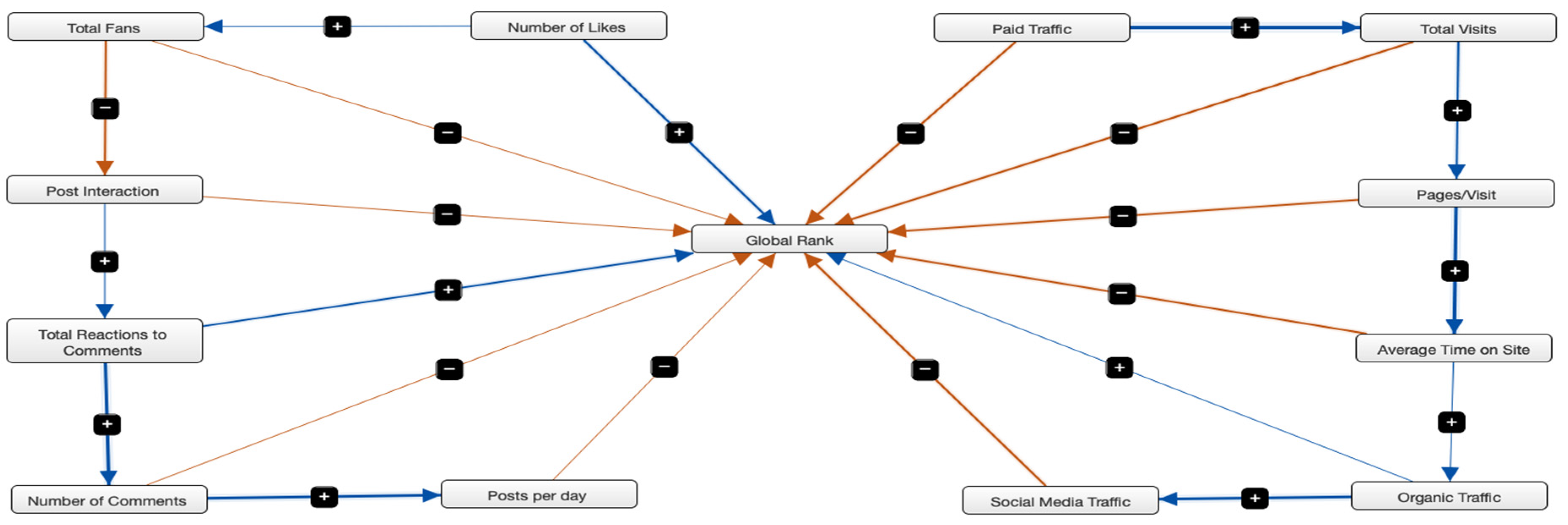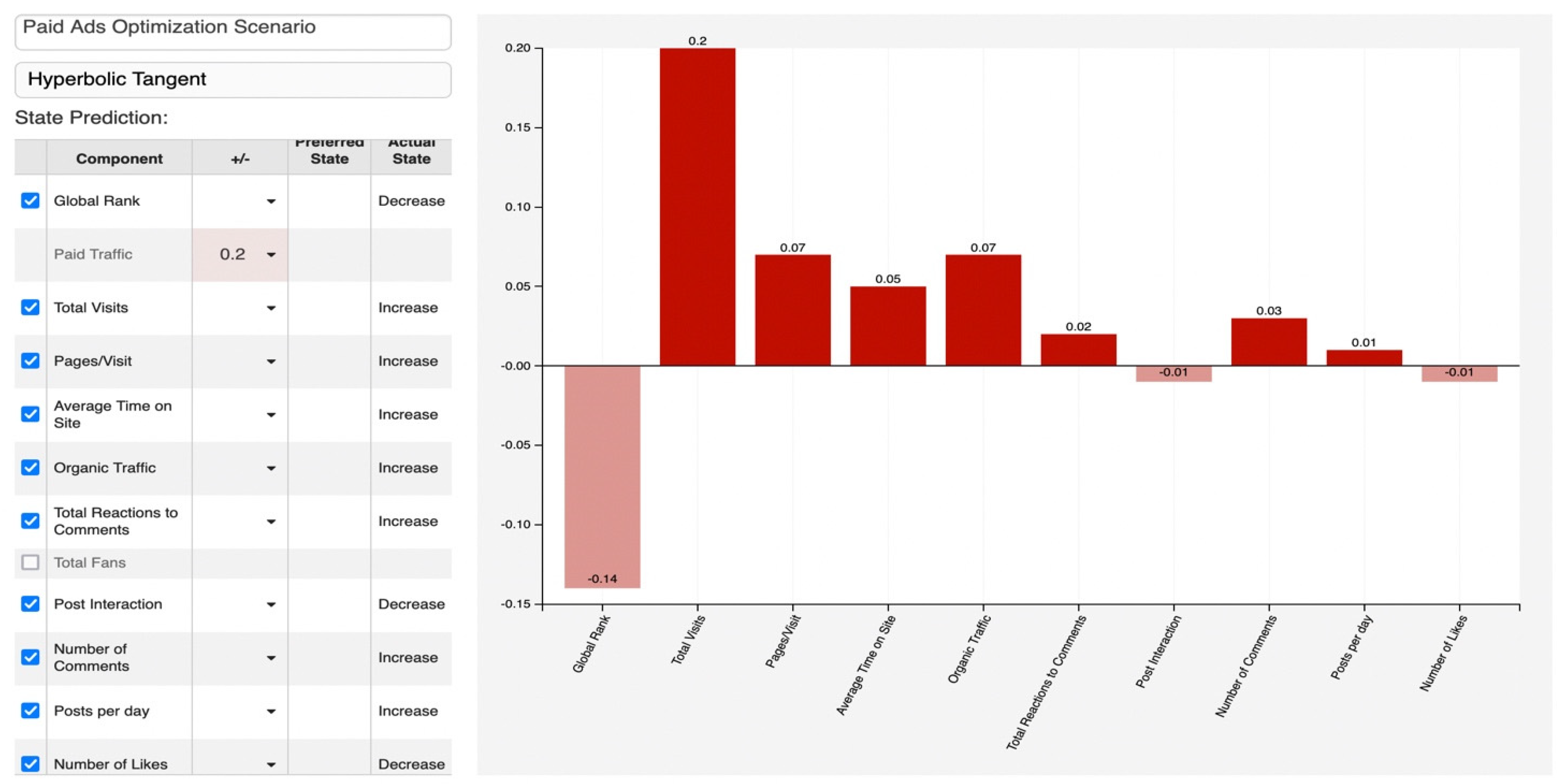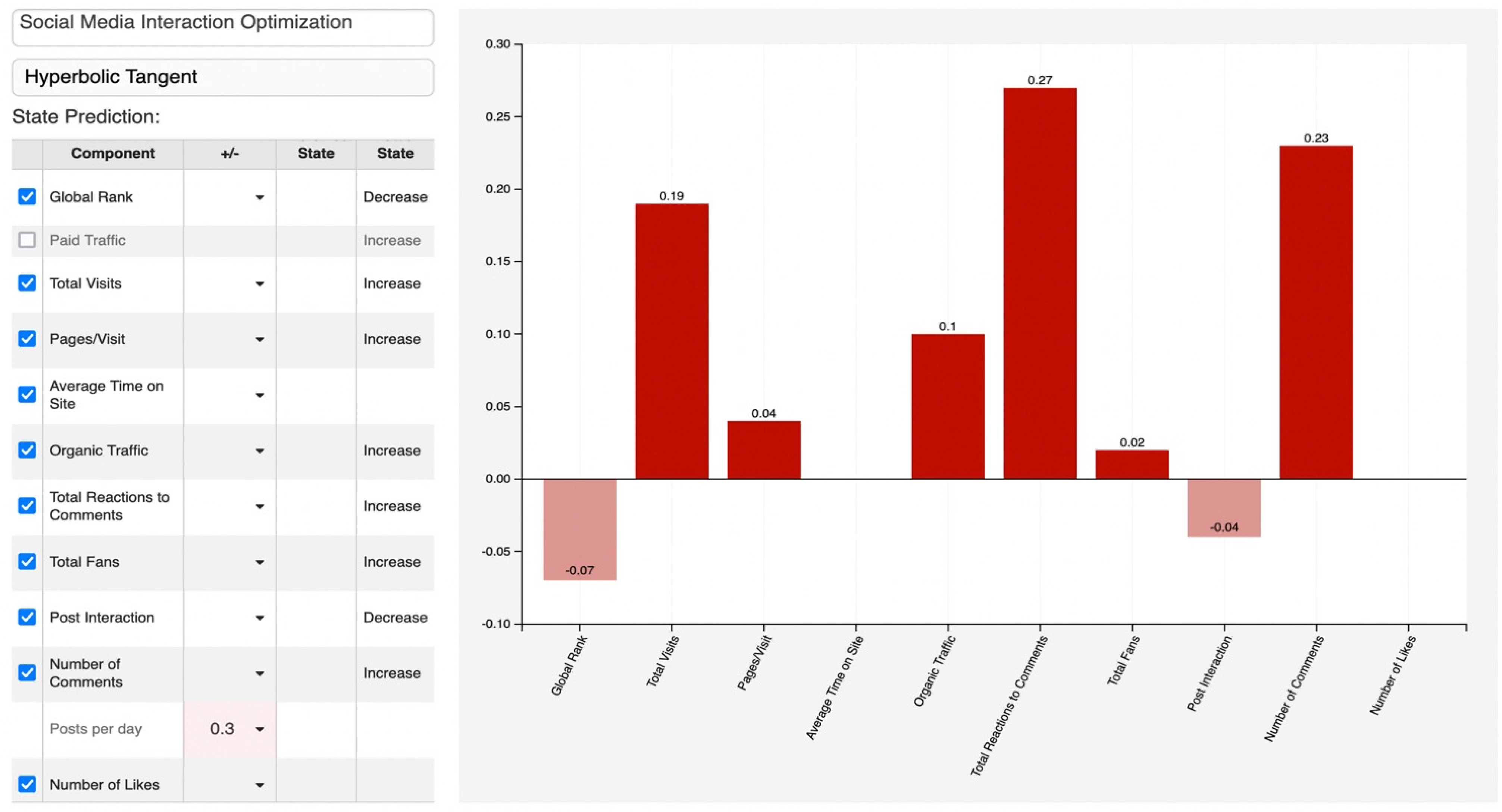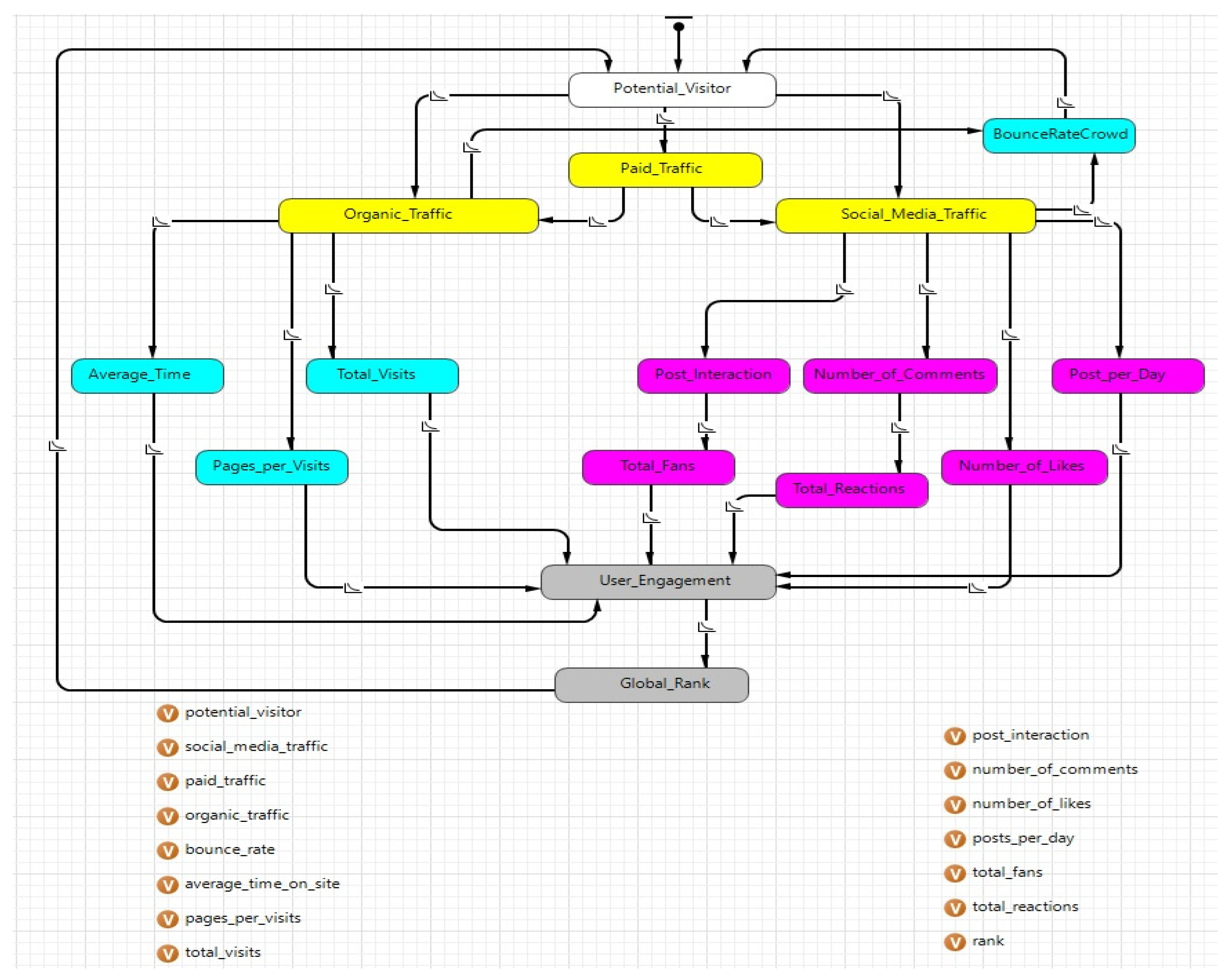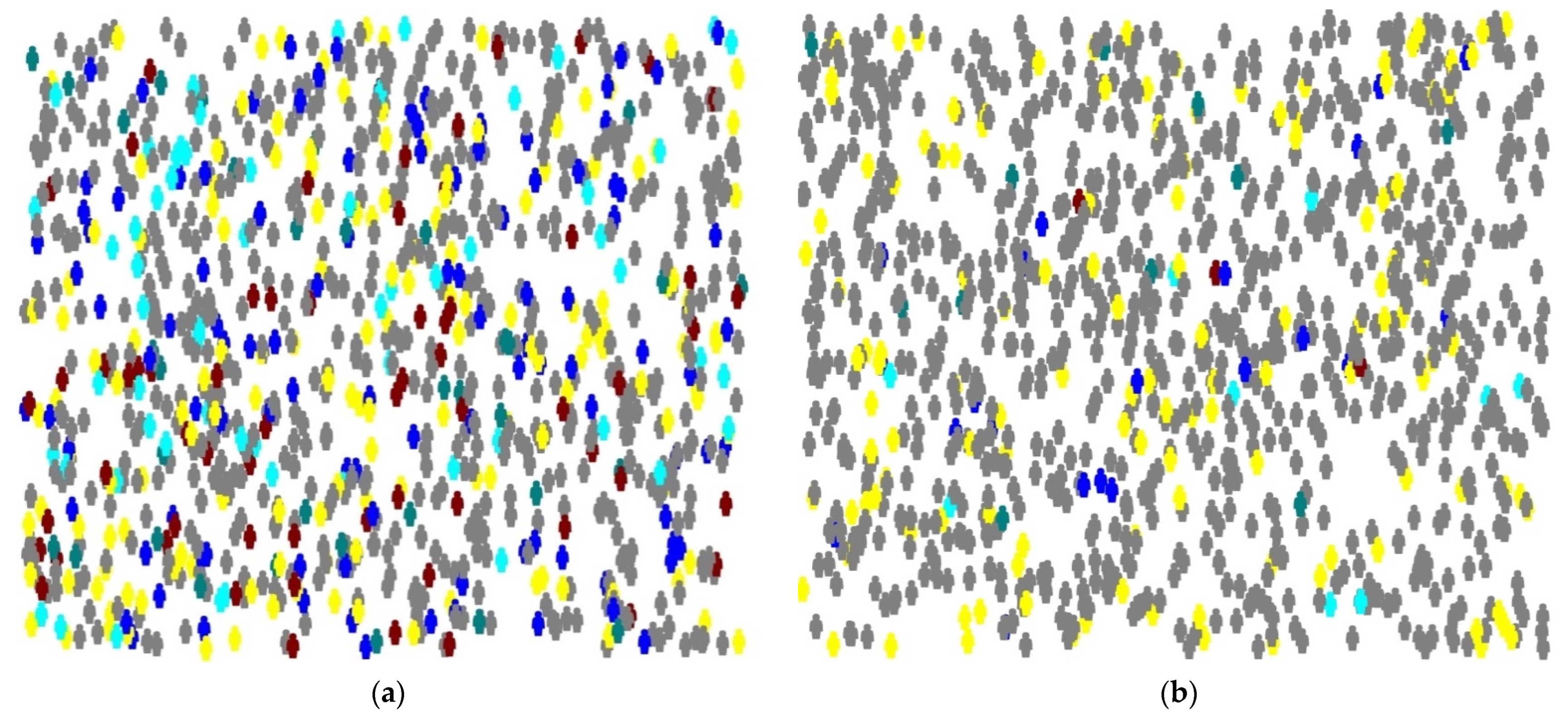The Internet has changed the way that tourism companies conduct business [
1]. The main lead generation of bookings derives from tourism websites and social media through advertisements or social media influencers [
2,
3,
4]. The amount of information being produced across high-traffic platforms and popular applications is thrilling. Every single minute, Facebook users’ share 240k photos, Twitter users’ post 575k tweets, Instagram users’ share 65k photos, Google conducts 5.7m searches, and 6m people shop online [
5]. Moreover, according to Statista, online users spend an average of 147 min per day on social medial platforms [
6]. Nowadays, travelers search online to choose their travel destination, accommodation, and restaurant based on online reviews, indicating that social media platforms are able to affect users’ booking process [
7]. For example, the crowd-sourced site TripAdvisor reached one billion reviews and opinions in 2021, a fact that demonstrates that travel inspiration happens through reviews, which is a factor that validates their booking process [
8].These impressive numbers lead to the conclusion that consumers are heavily engaged with social media platforms, and therefore, growing business and increasing traffic is more likely to happen online [
9,
10]. Customers seek information through various sources, leading businesses to carefully consider various touchpoints in their customers’ journey mapping. As multiple marketing channels make the way into our daily lives, making the buying process an intuitive procedure is the key to ensure that businesses’ limited resources will be efficiently allocated to reach customers and deliver personalized, hassle-free experiences [
11,
12].
Undoubtedly, social media platforms come along with multiple trust issues. According to the Edelman Trust Barometer [
13], the major information sources are not considered as trustful, with the level of trust in social media at only 37%. Online users receive information from social media platforms with skepticism [
14]. However, within the travel and tourism industry, social media should be seen as the gold mine of trust-building by evaluating reviews and opinions from multiple social media platforms. According to recent research, social media postings are considered unbiased and objective, with travelers relying more on them rather than on official tourist websites [
15]. Moreover, millennials tend to have the highest levels of trust on social media platforms, since they represent the majority of social media postings [
16]. In addition, social media influencers [
17] and brand awareness [
18] positively influence the booking process of users and augment trust levels within the tourism industry. According to Statista, 49% of the respondents claim to “somewhat trust” review sites, indicating that online reviews have become the new e-WOM [
19].
In the digital era, where there is a shift to an information-based economy, leveraging the power of popular social media is a powerful way to facilitate communication and achieve branding goals [
20]. Internet-based channels create new opportunities for companies to obtain a 360-degree view of customers, with the intention to mold a personalized image as a first step to improving business accessibility and visibility. Indeed, the current trend in business marketing fends off traditional marketing tools to employ social media approaches, which add greater value to the product or service on offer [
21]. From retargeting campaigns to personalized advertising, multichannel marketing approaches prove to be important in understanding the market pulse, driving in traffic, and predicting future trends.
Increasingly seen as a successful one-way path to customers’ purchasing intention [
22,
23] and brand loyalty [
24,
25], advertising in social media has attracted the attention of multiple researchers. Knoll conducted an empirical review in 51 studies to conclude that the use of advertising in social media is one of the seven emerging themes [
26]. Similarly, Alalwan et al. state that promotional and advertising efforts are one of the predominant themes and trends for the academia, suggesting further research [
27]. The digital transformation of the Hospitality, Travel, and Tourism (HTT) sector, with multiple mobile apps, websites, and social media platforms, offer tons of new avenues for the development of a better multichannel digital marketing strategy [
28]. For example, HTT could construct loyalty programs that compensate positive e-WOM marketing on social media in exchange for loyalty points [
29]
The study is allocated in 5 sections: The introductionis presented in
Section 1; the materials and methodological framework are defined in
Section 2, and the statistical analysis, as well as the Fuzzy Cognitive Map (FCM) and Agent-Based Model (ABM) findings, are presented in
Section 3.
Section 4 then summarizes the results, and
Section 5 concludes with practical and theoretical implications of the research.
1.1. Multichannel Marketing in the Digital Era
The new digitalized ecosystem requires constant changes so as to adapt to the ever-changing environment of social media trends as a way to effectively satisfy customers’ preferences [
30]. In an attempt to leverage the power of social media branding, companies are consistently looking for the right methods to effectively target their audience. Creating detailed user personas is challenging; however, it is the first step while developing a successful multichannel marketing strategy [
31]. Identifying where a company’s traffic is coming from, in terms of what channels they frequently use and switch between, allows active industry players to bring their business back. Social media platforms are no longer sterile platforms for virtual communities, but important business tools to boost sales opportunities and brand communication through a significant dual effect:by acquiring new followers and influencing new followers’ friends [
32].
Companies struggle to achieve optimal multichannel marketing activities since tracking the customer journey has become more difficult than ever. Customers, within the tourism industry, are constantly looking for personalized social media advertising experiences [
33], setting personalization as the foundation of this massive shift in consumer behavior. More and more consumers are looking for ways not merely to buy a product or a service, but to also feel engaged toward the brand they have selected [
34]. This process demands the development of a robust and strategic approach more personalized than ever before. Effectively executed personalization requires an update in personalized ads so as to reflect the digital transformation of consumers.
COVID-19 has accelerated consumers’ behavior to more digital services, heightening in this way their expectations for personalized experiences [
35]. Indeed, a number of variables, among which are customer innovativeness, internet experience, and channel experience, greatly contribute to the advancement of customer experience management, taking customer experience to the next level [
36]. That is to say that constant innovations in the HTT sector, such as mobile apps and the use of virtual reality, make tourism services more user-friendly and further advance the levels of customer experience as an antidote to brand building [
37]. The revolution in digital marketing lies in social media advertising personalization as the default standard for customers’ engagement with brands [
38]. As tailored advertising is getting smarter, the increase in customers’ conversions and leads generations fends off the traditional one-size advertising approaches, preferring instead personalization tactics that meet or even exceed customers’ needs and expectations [
39].
Multiple touchpoints exist today since consumers spend a great amount of time online, some of which are found on social media platforms. As such, companies struggle to find solutions on how to orchestrate their marketing activities across channels [
40]. Not only that, but also as consumers get savvier, the winds of change have moved the bottom-line from less environmental-friendly companies to those that adopt a more sustainable approach in favor of brand optimization [
41]. The Ad-Net-Zero Report is an important attempt of advertising professionals to support brand campaigns that promote sustainable behaviors [
42]. In fact, tourism companies that support environmental, social, and governance (ESG) principles in their business strategy are more likely to achieve higher levels of travelers’ loyalty [
43]. An interested work has been recently published by Polman and Winston, named
Net Positive [
44]. In this book, the authors strongly argue that the employment of a holistic, sustainable approach, from maximizing the benefits for products, services, and influence to employees, consumers, suppliers, communities, and more, lead companies to thrive. This is a trend that appeases not only travelers but the entire travel community as well, from travel stakeholders to investors [
45]. An interesting attempt has been made by Google Flights, where users can find carbon emission estimates on their flight search results [
46]. The stake for companies lies in decarbonizing their ads and environmental fingerprint in an attempt to offer personalized sustainable-focused marketing campaigns, which will become the new driver for competitive advantage [
47].
The question here is not whether personalized advertising will shape e-commerce in the future, it is how companies can gather and analyze the right data in favor of personalization, as the foundation of an effective multichannel marketing strategy. Exposure to superior e-business personalization demands a great amount of data to be collected. Noticeably, numerous studies have been devoted to social media efficiency in advertising activities [
48,
49,
50]. Moreover, multichannel retailing has been thoroughly investigated by researchers, indicating it as a win-win game contingent on market environments [
51,
52]. However, little research has been conducted on how multichannel shoppers react on different online social media platforms and how digital advertising messages could be best processed to potential customers. Lee and Cho identify the effect of big data on advertisement executions as one of the key trends pertaining to digital advertising [
53]. Zhang et al. acknowledge the importance of big data regarding customers’ satisfaction and brand awareness [
54]. Similarly, Chang, Kaufmann, and Kwon state that big data analysis is here to analyze social science phenomena in the real-world setting [
55].
Within the HTT industry, several works of research have been carried out using big data [
56,
57,
58,
59]. A very interesting study has been carried out by Xiang, Du, Ma, and Fan using social media data in the tourism and hospitality sector [
60]. This is one of the first studies to explore the contribution of social media to the HTT domain and pave the way for more research on this topic, such as tourist sites’ image posting [
61] and attractions in heritage parks [
62]. According to Xu, Nash, and Whitmarsh, social media analytics can contribute to the development of balanced methodological approaches, especially if combined with small data [
63]. The literature review reveals that there is a strong connection between big data and innovations within the tourism research [
64], a fact that opens new avenues for future research on social media analytics and the HTT sector. The benefits are dual: adopting big data artificial intelligence strategies can offer increased efficiency, productivity, and profitability to tourism businesses and personalized, convenient, and rich experience to customers [
65]
The landscape of digital advertising constantly changes, raising concerns regarding customer engagement and retention rate. Marketers need to re-evaluate their ads from massive targeting to personalized messaging in an attempt to meet current needs and anticipate new trends. The possibility of hypereffective ads lies on the prompt analysis of online customers’ behavior based on crowdsourcing data [
66].
1.2. Digitalization in the Travel and Tourism Industry
According to the World Economic Forum’s Digital Transformation Initiative, digitalization in aviation, travel, and tourism is expected to create up to USD 305 by 2025 [
67]. Advances in technology boost innovation and growth, allowing travel and tourist companies to replace traditional tourism in a more human-centric, personalized approach [
68]. Leveraging technology, such as the social media explosion, goes beyond digitalization; it introduces tools and activities that change the travel behavior from the beginning to the end and enables travel companies to stay ahead of the curve [
69,
70].
TCI research reveals that 31% of online users are willing to share their travel experiences even with users outside their friend zone [
71]. As such, social media should be seen as a part of customers’ decision-making process, able to shape perceptions [
72], and become an influential factor of selecting tourist destinations [
73]. It therefore becomes apparent that by harvesting data and analytics, travel and tourist companies acknowledge behavioral patterns that will help them build targeted marketing campaigns on a larger scale.
Undoubtedly, social media and tourism marketing comprise an incredible opportunity, a perfect match for growth and development of existing activities and future trends within the travel industry. Social media analysis empowers brands with useful insights so as to increase guest engagement, gain competitive advantage, and achieve business superiority within the tourism sector [
74,
75]. In August 2021, a survey was conducted in the United States to determine the online travel brands with the best social media presence [
76]. A total of 34% of the respondents voted for booking.com and 25% for Expedia. However, the systematic use of social media before, during, and after trips depends greatly on the nationality of travelers [
77]. One main concern of the popularity of social media platforms is strongly associated with cultural values. Social media tears down national boundaries, and it is the local culture that seems to face the most challenges [
78]. Based on a recent paper, 40% of the respondents’ cultural identity seems to be affected by the use of social media [
79]. Apart from gradually losing their local identity and adopting a cross-cultural one, one could further encounter posts containing feelings that violated their cultural values. Nevertheless, one thing is for sure: social media is here to stay and those companies who manage to engage critically with the dynamics that unfold, by fighting an uphill battle, will win the race of competitiveness [
80].
The role of social media has been further researched in multiple sectors, among which are hospitality, tourism, and travel [
81]. In 2021, advertisers in the United States were projected to spend nearly USD 106 billion on programmatic digital display advertising, which is expected to increase to nearly USD 142 billion by 2023 [
82]. According to a study conducted in the fourth quarter of 2021, approximately 24 percent of surveyed Spanish consumers aged between 18 and 29 years looked at posts on social media for holiday inspiration, and 21 percent of Dutch respondents aged 45 years and older claimed to do the same [
83]. It is evident that both the tourism industry [
84] and travelers [
85] greatly rely on the use of social media platforms as a way to inspire or get inspired, respectively.
It is apparent that tourism advertising in social media requires further investigation [
86].Hanouda states the positive impact of online users toward social media advertising and highlights the need for future research in the social advertising field within the travel and tourism industry [
87]. Several recent works of research in the hospitality, tourism, and travel (HTT) industry exist, exploring interesting topics that mainly look at the role of social media on brand trust [
88], sharing behavior [
89], tourism information quality [
90], destination marketing and image [
91,
92,
93], among others, showing that social media marketing can affect consumers’ online decision-making process [
94]. One of the latest studies in the HTT sector identifies that social media advertising is an understudied research field, suggesting future research should be concentrated on social media platforms as an advertising medium [
3]. The authors further advise future studies that will overcome the national borders and adopt a cross-national identity. Having that said, the current study attempts to fill this gap and therefore focuses on social media advertising within the HTT industry at a global level. The paper extracts data from 10 world leading tourism websites in an attempt to study the behavioral patterns of online users. Given the great attention that has been given to the relationship between online reviews and online users [
95], the present study investigates the interconnection between social media advertising across multiple channels in favor of tourism businesses’ brand optimization.
Implementing successful multichannel approaches is a difficult task in business, especially in understanding customers’ behavior [
96]. Having this in mind, and with an eye to big data-driven technology, the authors focus on the role of implementing a multichannel marketing strategy, with a special interest in social media channels, as a cornerstone to encourage customer engagement, increase sales opportunities, and build brand awareness and visibility across digital platforms. Since advertising on social media is seen as an emerging trend within the tourism sector, the present study is devoted to understanding the importance of new digital technologies in shaping users’ purchasing intentions and building brand awareness and stability.
1.4. Formulation of Research Hypotheses
To acquirea competitive advantage, tourismenterprisesmust assess their surroundings using all accessible resources, especially thedigital ones [
110]. Some crucial elements that need to be taken under consideration are the users’ behavioral factors on the corporate website, such as “average time on site” and “pages per visit”, as well as the behavioral factors of the users on social media, such as “post interaction” and “number of likes”. The analysis of those factors can provide a holistic view of the user engagement and corporate digital brand name [
111].
The study’s findings will help decision-makers and marketers determine the optimal multichannel digital marketing strategythat distinguishes one tourismenterprise from another.More precisely, decision-makers may maximize digital investments by analyzing site analytics and combining them into a broader plan to boost the company’s digitalbrand name [
112,
113]. Tourismmarketers can develop competitive differentiation by incorporating websites and social mediabig data in their strategy [
114,
115]. The following hypotheses were developed to explore the impact of social media and websitebig data on interactivity, user engagement, and digitalbrand name.
Hypothesis 1 (H1). “Paid Traffic” of tourism enterprises affects the “Social Media Traffic” variable through their “Post Interaction” metric.
This hypothesis studies the effects of paid traffic on social media traffic as well as the effects of interactivity between the users and the tourismsocial media on social media visibility. This hypothesis will provide valuable insights on social media lead generation. Additionally, it is crucial for marketers to identify the effects of paid traffic on the post interaction metric and the corporate social media in total, in order to have a clear view of the intercorrelation of the metrics when creating a digital marketing campaign [
116].
Hypothesis 2 (H2). “Number of Comments” of tourism enterprises affects the “Total reactions on posts” variable through their “Posts per day” metric.
A previous study has revealed that the total reactions to social media posts have a positive impact on user engagement and on social media marketing in general [
111]. Hence, the second hypothesis attempts to examine the social media interactivity of tourismenterprises. The holistic interactivity can be revealed with the examination of the number of comments per post, the number of posts per day, and their effects on the total user reaction to those posts.
Hypothesis 3 (H3). “Social media traffic” of tourism enterprises affects the “Total visits” variable through their “Pages per visits” metric.
After assessing the interactivity of behavioral metrics and their effects on corporate social media, the third hypothesis examines how the effects of social media activity affect the tourism website visibility. This is a crucial hypothesis for multichannel marketing since all platforms (social media and corporate websites) must achieve high visibility in order to produce optimal profitability [
10,
117].
Hypothesis 4 (H4). “Social media traffic” of tourism enterprises affects the “Organic traffic” variable through their “Total visits” and “Number of fans” metrics.
As previous studies have revealed, from the logistics industry to tourism, the steady growth of the metric organic traffic is a valid indicator for the growth of the global rank metric [
41,
69]; it is crucial to research the effects of social media traffic on this metric. Therefore, the fourth hypothesis examines the effects of social media activity and website activity on the website’sorganic traffic. Since the variable organic traffic is calculated from all unpaid sources [
68], such as users that type booking.com into a search engine or browser and are not redirected from an advertisement, it has been established as the main precursor of the website’s digital brand name [
118].
Hypothesis 5 (H5). “Average time on site” of tourism enterprises affects the “Global rank” variable through their “Number of likes” and “Pages per visit” metric.
After identifying the effects of social media and website behavioral factors on the organic traffic metric, the fifth hypothesis examines if the digital brand name represented with the global rank metric is affected by the average time spent on the website, the pages viewed per visit, and the number of likes on corporate social media. For marketers, it is crucial to identify if those metrics affect the digital brand name and to what extent in comparison with other industries [
105,
119] in order to produce an effective digital marketing campaign.
As a result, theseresearch hypotheseshave been developed to comprehensively assessthe main multichannel marketing study. More precisely, tourismenterprises need toidentify and invest in the parameters that affect their social media traffic (H1). Then, it would be useful to explore which parameters of the corporate social media could add value to their website’s interactivity and visibility (H2, H3). Furthermore, it is critical to understand how the above parameters can be optimized to assist the corporate website to climb in search engines and improve its digitalbrand name (H4, H5).
